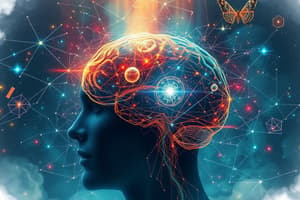Podcast
Questions and Answers
What did Gestalt psychologists argue regarding figure-ground segregation and object recognition?
What did Gestalt psychologists argue regarding figure-ground segregation and object recognition?
- They thought figure-ground segmentation and object recognition happen simultaneously.
- They believed figure-ground segregation happens after object recognition.
- They believed figure-ground segregation occurs before object recognition. (correct)
- They found that object recognition is not related to figure-ground segregation.
How does recognition of an object influence figure-ground segmentation according to recent studies?
How does recognition of an object influence figure-ground segmentation according to recent studies?
- Knowledge of the object helps in figure-ground segmentation. (correct)
- It only aids in object recognition, not figure-ground segmentation.
- It has no effect on figure-ground segmentation.
- It makes figure-ground segmentation more difficult.
What is a negative aspect of Gestalt psychologists' approach to perception?
What is a negative aspect of Gestalt psychologists' approach to perception?
- They acknowledged the importance of experience in perception.
- They provided a comprehensive explanation of visual phenomena.
- They failed to explain the underlying processes of perception. (correct)
- They emphasized the role of top-down knowledge in perception.
Pattern recognition is essential for which process?
Pattern recognition is essential for which process?
What challenge does pattern recognition face based on the content provided?
What challenge does pattern recognition face based on the content provided?
What does Biederman's recognition-by-components theory primarily focus on in object recognition?
What does Biederman's recognition-by-components theory primarily focus on in object recognition?
How does the deletion of concavity information affect object recognition according to the experiments?
How does the deletion of concavity information affect object recognition according to the experiments?
What is a significant finding related to object recognition mentioned by Foster and Gilson (2002)?
What is a significant finding related to object recognition mentioned by Foster and Gilson (2002)?
In what way does face recognition differ from object recognition?
In what way does face recognition differ from object recognition?
Why might Biederman's recognition-by-components theory be inadequate for certain objects?
Why might Biederman's recognition-by-components theory be inadequate for certain objects?
How does the familiarity of an object influence object recognition?
How does the familiarity of an object influence object recognition?
What phenomenon suggests that holistic processing is involved in face recognition?
What phenomenon suggests that holistic processing is involved in face recognition?
What is the primary role of geons in object recognition?
What is the primary role of geons in object recognition?
What is the primary basis for template theories in pattern recognition?
What is the primary basis for template theories in pattern recognition?
According to feature theories, how are patterns recognized?
According to feature theories, how are patterns recognized?
What limitation is associated with template theories of pattern recognition?
What limitation is associated with template theories of pattern recognition?
What key concept is highlighted by Hubel and Wiesel's discovery of feature detectors?
What key concept is highlighted by Hubel and Wiesel's discovery of feature detectors?
What is the object superiority effect in pattern recognition?
What is the object superiority effect in pattern recognition?
Which of the following is a characteristic of complex cells discovered by Hubel and Wiesel?
Which of the following is a characteristic of complex cells discovered by Hubel and Wiesel?
How do both bottom-up and top-down processes interact in pattern recognition?
How do both bottom-up and top-down processes interact in pattern recognition?
Why are template theories considered inflexible in explaining pattern recognition?
Why are template theories considered inflexible in explaining pattern recognition?
What is the primary distinction between sensation and perception?
What is the primary distinction between sensation and perception?
Which law of perceptual organization suggests that elements that are close together tend to be grouped together?
Which law of perceptual organization suggests that elements that are close together tend to be grouped together?
What does the law of Pragnanz state?
What does the law of Pragnanz state?
Which of the following best describes figure-ground segregation?
Which of the following best describes figure-ground segregation?
In the context of perceptual organization, what does the law of similarity imply?
In the context of perceptual organization, what does the law of similarity imply?
What characterizes visual illusions?
What characterizes visual illusions?
Which of the following is NOT a law of perceptual organization in Gestalt psychology?
Which of the following is NOT a law of perceptual organization in Gestalt psychology?
Why do we find visual illusions compelling and amusing?
Why do we find visual illusions compelling and amusing?
What does the composite face illusion demonstrate about face processing?
What does the composite face illusion demonstrate about face processing?
Which condition refers to an individual’s severe impairment in recognizing faces?
Which condition refers to an individual’s severe impairment in recognizing faces?
Which type of agnosia is characterized by intact perceptual processes but difficulties in accessing knowledge about objects?
Which type of agnosia is characterized by intact perceptual processes but difficulties in accessing knowledge about objects?
How is apperceptive agnosia primarily different from associative agnosia?
How is apperceptive agnosia primarily different from associative agnosia?
Which of the following methods is suggested for testing face recognition ability in individuals unfamiliar with celebrity faces?
Which of the following methods is suggested for testing face recognition ability in individuals unfamiliar with celebrity faces?
What is the primary focus of the Famous Faces test?
What is the primary focus of the Famous Faces test?
In what way does the face inversion effect manifest in individuals?
In what way does the face inversion effect manifest in individuals?
Which psychological principle is primarily focused on in the study of visual agnosia?
Which psychological principle is primarily focused on in the study of visual agnosia?
Study Notes
Sensation and Perception
- Sensation: The process of taking in information through our senses and converting it into signals the brain can understand.
- Perception: The interpretation and understanding of these sensory signals.
- Visual perception is our most dominant sense.
Laws of Perceptual Organization
- Gestalt psychologists emphasized the law of Pragnanz: We perceive the simplest possible organization of the visual environment.
- The Gestalt Laws:
- Proximity: Elements close together are grouped.
- Similarity: Similar elements are grouped.
- Continuation: Lines are seen as following the smoothest path.
- Closure: Incomplete figures are perceived as complete.
- Figure-ground segregation: The visual environment is separated into a figure (with distinct form) and a ground (lacking form).
Pattern Recognition
- Pattern recognition: The identification of two-dimensional patterns, necessary for object recognition.
- Matching: The process of comparing the stimulus to stored categories in memory.
- Theories:
- Template theories: Recognition occurs when a stimulus closely matches a stored template.
- Feature theories: Patterns are identified by matching their features.
- Hubel & Wiesel: Discovered simple and complex cells in the occipital cortex, responsible for processing basic visual features and combinations of features.
- Object Superiority Effect: Features are processed more easily when part of a meaningful object.
Object Recognition
- Object recognition occurs when a mental representation is activated strongly enough to be interpreted as the most likely interpretation.
- Recognition-by-components theory (Biederman):
- Edges are extracted and combined into basic shapes called geons (geometric ions).
- These geons are the building blocks of object recognition.
- Counter-evidence: Objects without geons (clouds, fire) rely more on top-down knowledge and experience.
Face Recognition
- Face recognition is more holistic than object recognition (affected by the whole picture, not just parts).
- Evidence:
- Part-whole effect memory study.
- Composite face effect: Difficult to separate the top half of a face when matched with a different bottom half.
- Face inversion effect: Faces are harder to recognize upside down.
Disorders of Perception
- Visual agnosia: Difficulty recognizing objects visually.
- Apperceptive agnosia: Impaired perceptual processing.
- Associative agnosia: Intact perceptual processes, but difficulties accessing object knowledge from memory.
Studying That Suits You
Use AI to generate personalized quizzes and flashcards to suit your learning preferences.
Related Documents
Description
Explore the fascinating concepts of sensation and perception, two fundamental processes that shape our understanding of the world. This quiz delves into the laws of perceptual organization and how we recognize patterns. Enhance your knowledge of how our senses work and how we interpret sensory information.




